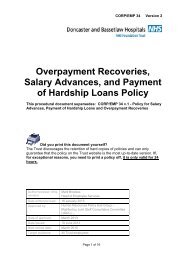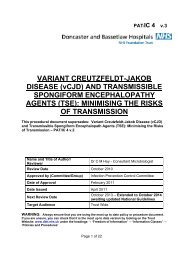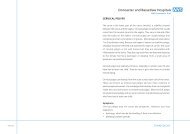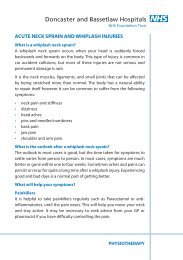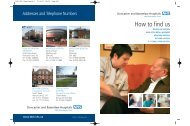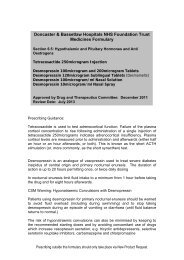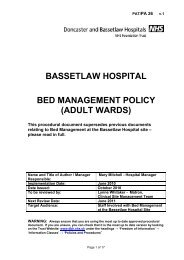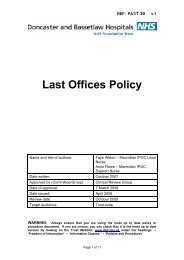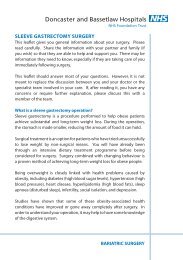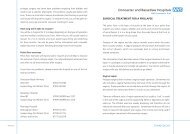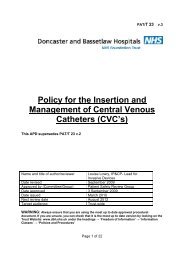evidence based mouth care policy - Doncaster and Bassetlaw ...
evidence based mouth care policy - Doncaster and Bassetlaw ...
evidence based mouth care policy - Doncaster and Bassetlaw ...
Create successful ePaper yourself
Turn your PDF publications into a flip-book with our unique Google optimized e-Paper software.
• STANDARD MOUTH CARE<br />
Page 10 of 21<br />
REF: PAT/PA 17 v.1<br />
From the literature reviewed, the authors recognise the importance of regular oral hygiene (Turner<br />
1995, Buglass 1995, Thurgood 1994, Kite <strong>and</strong> Pearson 1995). Buglass (1995) argues that<br />
frequency is more important than the agents used.<br />
Basic st<strong>and</strong>ard <strong>mouth</strong> <strong>care</strong> – (Literature states that the frequency of carrying out basic <strong>mouth</strong> <strong>care</strong><br />
is more important than the agents which are used to facilitate <strong>mouth</strong> <strong>care</strong>) Buglass EA 1995 Oral<br />
Hygiene British Journal of Nursing 4 (a) 516-519. Guidelines for Oral Care BDA April 2000.<br />
Guidelines for Record Keeping (2002). London Nursing <strong>and</strong> Midwifery Council.<br />
There is however, no general agreement regarding how frequently <strong>care</strong> should be given or the tools<br />
<strong>and</strong> agents which should be used. (Buglass 1995). For the purpose of our guidelines we have<br />
agreed st<strong>and</strong>ard <strong>care</strong> entails 12 hourly tooth brushing using a soft brush <strong>and</strong> toothpaste as research<br />
suggests the massaging effect of a soft brush stimulates mucosa promoting healthy gums. It is also<br />
the most effective way to loosen debris <strong>and</strong> remove plaque without causing trauma providing that<br />
<strong>care</strong> is taken (Thurgood 1994), Ransier et al 1995, Kite <strong>and</strong> Pearson 1995). Rinsing well with warm<br />
water is important as any remaining toothpaste may have a drying effect.<br />
Toothpaste gives a pleasant taste; always use a fluoride paste or Corsodyl gel if gingivitis is<br />
present.<br />
For patients with dentures the literature states all dentures should be removed overnight to prevent<br />
shrinkage. Debris must be removed as c<strong>and</strong>ida may be present <strong>and</strong> be harboured in the dentures<br />
therefore prevents introducing/ reintroducing infection. Dentures should be stored in a clean, dry<br />
container.<br />
Evidence suggests reassessment of the oral cavity should occur every 12 hours to ensure ongoing<br />
<strong>care</strong> is maintained. The flowchart should be used to aid assessment.<br />
Patient Requiring Assistance<br />
Often patients require assistance with oral hygiene. St<strong>and</strong>ard <strong>mouth</strong> <strong>care</strong> should be maintained. In<br />
addition, water soaked swabs may be required to keep the <strong>mouth</strong> moist. Suction may also be<br />
required to remove excess secretions. The use of soft paraffin ointment to the lips will keep them<br />
moist <strong>and</strong> prevent them from drying <strong>and</strong> cracking. (Turner 1995).<br />
Somerville (1999) suggests nurses, in particular intensive <strong>care</strong> nurses, are fearful of using tooth<br />
brushes especially in intubated patients preferring to the use of sponge sticks. However, this is not<br />
effective in the removal of plaque <strong>and</strong> debris. There is also the danger of the sponge becoming<br />
separated from the stick. Therefore sponge sticks are not recommended.<br />
Ulceration<br />
If ulceration is present, but there is no c<strong>and</strong>ida coating the tongue teeth or mucosa, Difflam<br />
<strong>mouth</strong>wash should be used in addition to st<strong>and</strong>ard <strong>mouth</strong> <strong>care</strong>. Difflam enhances oral <strong>care</strong> as it<br />
contains a topical anaesthetic <strong>and</strong> has anti-inflammatory <strong>and</strong> anti-microbial properties (Thurgood<br />
1994). However, it has numbing analgesic effect <strong>and</strong> must be prescribed by medical staff.



